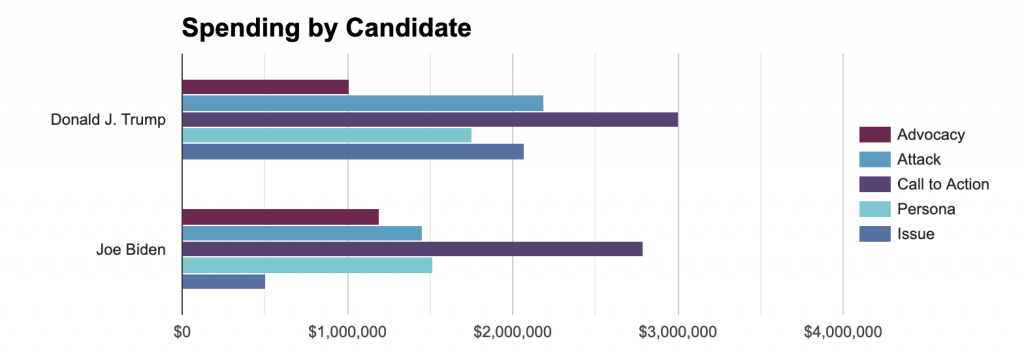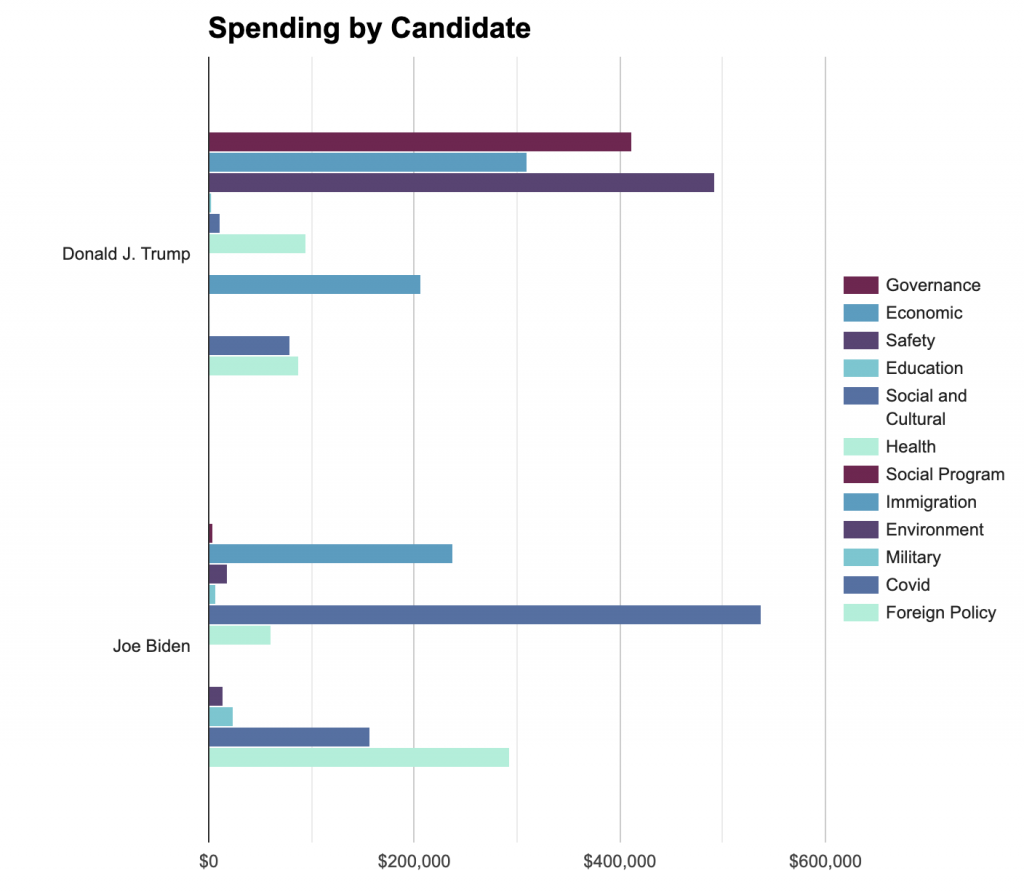
By Hailey Womer
This post was updated on 11/1/2020. The original post underestimated spending by the Biden campaign. Illuminating 2020 estimates for both campaigns were updated throughout the post, including text and figures. The original post included a statement indicating that Biden was spending the most money targeting women 65+. This statement has been updated in the current post to note that Biden is currently spending the most money targeting women ages 35-44 based on Illuminating 2020 current estimates.
Historically, youth voters (ages 18-29) have had the lowest voter turnout when participating in national and local elections. While the youth voter turnout in the 2018 midterm election was at an all-time high, only 28% of eligible youth voters cast their votes. With 23 million eligible Gen Z voters this year, almost 16 million more than could vote in the 2016 election, this large but historically inactive voting demographic is a challenging yet necessary group of voters that presidential candidates Joe Biden and Donald Trump have targeted using Facebook and Instagram advertisements. Using the Illuminating Data, we are able to break down how each candidate is tackling the younger portion of this demographic (ages 18 to 24) and how much money they have spent between Jun. 1 and Oct. 25 in order to win over these young adults. Through these advertisements, both candidates have different strategies on how to reach young adults, but employ these strategies in a way that targets social issues young Americans care about in attempts to mobilize this age group.
Ad Spending by Age
As of Oct. 25, the candidates have spent an estimated $162,223,135 on Facebook and Instagram ads since Jun. 1 (estimates based on ads run from the candidates’ main Facebook pages and their corresponding vice presidential candidates’ pages) . Biden has narrowly outspent Trump by an estimated $887,321, with $81,555,228 going towards ads compared to Trump’s $80,667,907. Despite these large budgets, both candidates have allotted only a small portion of their money towards 18-24 year-olds. Biden has spent an estimated $6,670,193 and Trump has spent an estimated $4,338,966 targeting 18-24 year-olds. The age groups are broken down as follows.

Both candidates have focused the majority of their spending on other age segments, with the 18-24-year-old age group receiving the least amount of money. When analyzing Trump’s spending, the data shows that he is focusing his efforts on those ages 65 and older. His spending then steadily decreases with each younger segmentation. His spending habits demonstrate a push with older age groups, leaning into the fact that the older demographic of voters show up in greater numbers on election day than younger voters.
Biden, on the other hand, has allotted his differently, spending the majority of his money on the 35-44, 55-64, and 65+ age groups. He has allotted about $18 million to each of these age groups with the 25-34 and 45-54 age groups receiving about 1-2 million less. This spending focus differs greatly from Trump, focusing his spending efforts more uniformly across each voting age demographic and demonstrating his campaign’s appeal towards older millennials and above. Regardless of the differences in spending strategy, both candidates spend significantly less money targeting 18-24 year-olds than other age groups.
Gender
When looking at gender, Biden’s ad spending targets women more than men across the board while Trump’s ad spending targets men more than women. In the 18-24 category, these statistics remain true, with Biden spending an estimated $3,824,127 on ads targeting women and $2,578,054 on ads targeting men, and Trump spending $1,686,204 targeting women and $2,351,746 targeting men. When comparing the youth demographic to older demographics like those 55-64, both candidates are spending more on both genders in the older age groups. In the age groups older than the age of 45, Trump is spending significantly more money targeting women, outspending his ads targeting men 55 and older. Biden on the other hand, steadily focuses his spending on women in every age group, spending the most money targeting women between the ages of 35 and 44. As Trump continues to struggle to win over older suburban women, his spending reflects his campaign’s strategic use of facebook advertisements to reach this demographic.

Location
In a tight race, ad placement and their geographical location become increasingly important. For Biden, his top targeted states for 18-24 year-olds are Florida, Pennsylvania, Michigan, and North Carolina. For Trump, his top states in this category were Florida, Pennsylvania, North Carolina, and Georgia. Trump’s top overall ad spends by state are in Florida, Pennsylvania, North Carolina, and Texas while Biden’s are in Florida, Pennsylvania, Michigan, and California. Both candidates focused their spending regardless of age on highly contested states like Florida and Pennsylvania or states with a lot of electoral votes like California and Texas.
Message Type, Topic and Tone
It’s important to examine not just who these campaigns are targeting in their ads, but also the messaging they are using in these ads to try to persuade potential donors and voters. To help make these messaging strategies more transparent, the Illuminating project classifies ads by message type, topic, and tone of each ad. When analyzing an ad’s message type, it is classified into five categories: advocacy, attack, persona, issue, and call to action. When analyzing an ad by its topic, an ad can be classified into the Governance, Economic, Safety, Education, Social and Cultural, Health, Social Program, Immigration, Environment, Military, COVID, and Foreign Policy categories. Message tone classified ads as being civil or uncivil.
Message Type
When combining all age groups, Biden and Trump spend the most money on ads classified as Call to Action ads. The same reigns true for targeting 18-24 year-olds, with Biden spending an estimated $2.7 million and Trump spending an estimated $3 million on Call to Action ads. When targeting those in the 18-24 year-old demographic, the two candidates differ in their two second-highest categories, where Trump’s are Issue and Attack, and Biden’s are Attack and Persona. The largest difference in the candidates’ message type usage towards this age group comes with the Issue and Advocacy categories. While Trump has spent about $2 million on Issues related ads targeting 18-24 year-olds, Biden has focused the least amount of spending on this category, spending about $500,000.
When comparing spending by message type targeting 18-24 year-olds vs. spending on all age groups combined, both candidates are not targeting 18-24 year-olds drastically different than other age demographics. For those over the age of 35, both candidates spend more money focused on the Persona category while spending less on issue-related ads. Because this demographic of voters historically have a lower overall voter turnout, having a youth presence at the polls could make a significant difference in the result of the election. Trump’s spending on ads discussing the issues could be targeting first-time voters, who fall in the 18-24 year-old demographic. Highlighting issues in ads targeting this audience could be an attempt to educate young voters and shape their voting perceptions early on.

Message Topic
The topics each candidate chooses to focus on in their ads vary. Including all age demographics, Trump spends most on Safety, Economic, and Governance related ads, while Biden spends more on Social & Cultural, Foreign Policy, and Economic. When comparing the amount spent on each topic category by each candidate for the 18-24 year-old demographic, Trump outspent Biden in every category but Social and Cultural, COVID, Foreign Policy, Environment, Military, and Health focusing his money on safety-related advertisements.
When comparing spending between age demographics, Biden spent more on Social and Cultural ads targeting 18-24 year-olds than those in the 55-64 year-old demographic as well as the 65+ demographic. Those in the millennial age demographic between 25 and 34 also received a larger sum of money targeting this topic, demonstrating that the Biden campaign is primarily targeting younger adults with Social and Cultural ads. This focus on social issues and engagement likely stems from a large increase in political activism from young voters since the last election, with 27% of voters between the ages of 18 and 24 reporting they have attended a march or demonstration in the last year, and only 5% reporting this after being asked before the 2016 and 2018 elections. In comparison to Trump, Biden also proportionally focuses more on COVID related ads than his opponent, spending an estimated $156,812 on COVID ads targeting 18-24 year-olds compared to Trump’s $78,795. As Trump’s messaging related to the coronavirus has changed frequently since March, Biden is likely trying to remain firm in his own messaging.
Trump spent overall more on older demographics than 18-24 year-olds in each message topic category, further demonstrating his target audience. Despite spending more money on older demographics, Trump is still allotting the most money towards safety-related messages among his ads targeting 18-24 year-olds, spending $446,802. As stated earlier, young people have been very active in recent protests and marches and care a lot about issues relating to these movements. Many of Trump’s safety-related ads oppose defunding and abolishing the police, a hot-button issue that many people have strong feelings about. According to recent polling, 35% of voters between the ages of 18 and 29 oppose “defunding the police” and 51% oppose “abolishing the police.” With a large percentage of youth voters opposing these issues, Trump is likely targeting this age group with safety-related ads to resonate with the majority’s viewpoint.

Message Tone
When it comes to the civility of both candidates’ ads, both candidates spend the most on civil rather than uncivil ads regardless of age. However, while Biden spent only $255,249 on uncivil ads compared to roughly $6.1 million for civil ads for 18-24 year-olds, Trump spent $2,748,363 on civil ads to $1,303,233 on uncivil ads. This ratio remained similar for all age groups and demonstrated the greater usage of an uncivil tone overall for the Trump campaign in comparison to the Biden campaign.

While both candidates are focusing the majority of their spending on older demographics, both campaigns are still spending millions of dollars in advertisements targeting 18-24 year-olds. This sizable allotment demonstrates that while the youth vote is not the dominant demographic of eligible voters, it is still an important group of voters to target with online ads, especially considering the makeup of social media users. The candidates spending behavior shows that this demographic is particularly important in swing states like Florida and Pennsylvania, while also demonstrating the candidates’ stark difference in the message type, tone, and topic when reaching this age group. As youth voters have become increasingly more invested in social and cultural issues in recent years, both candidates appeal to this interest by spending the most on Call to Action ads, encouraging young adults to get involved. When looking at ads by topic, Biden is appealing directly to young adults’ interest in social issues and the pandemic. Trump focuses his ads more on safety and issue related messages, likely doing so to persuade young voters and discuss current events affecting young people. Overall, both candidates use slightly different messaging and tones but have many similarities in how they are trying to energize young adults.
All spending and impression amounts are estimates based on data provided by the Facebook Ad Library API. Estimates in the gender, location, and message sections are for each candidate’s main Facebook page only. Feature Photo by Markus Spiske from Pexels
